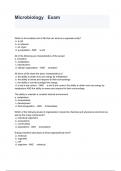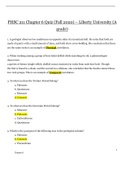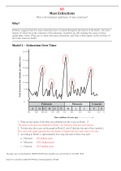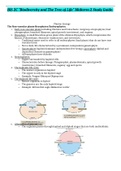Carboniferous period Study guides, Class notes & Summaries
Looking for the best study guides, study notes and summaries about Carboniferous period? On this page you'll find 32 study documents about Carboniferous period.
Page 2 out of 32 results
Sort by

-
UGS 303 Review, UGS 303 Ideas of the 20th Century Final (Bonevac), UGS303, Ideas of the 20th Century, UGS Bonevac Quizzes (TEST BANK) GRADED A
- Exam (elaborations) • 172 pages • 2024
-
- $15.49
- + learn more
If God is dead, Ivan Karamazov insists, everything is permitted An invention of the late 1800s: the light bulb The problem of normativity concerns the gap between is and ought Nietzsche wants science to become more playful Dostoevsky: the vision of the anointed inevitably leads to narcissism A two-level theory includes a deep level that ____ what happens at the surface level. determines and explains Doyle's vision is tragic in that Sherlock Holmes has to mak...

-
AP Environmental Science Review
- Exam (elaborations) • 89 pages • 2023
-
- $13.99
- + learn more
1. population composed of all individuals that belong to the same species and live in a given area at a particular time 2. community incorporates all of the populations of organisms within a given area 3. population ecolo- gy the study of factors that cause populations to increase or decrease 4. population size the total number of individuals within a defined area at a given time 5. population densi- ty 6. population distriu- tion the number of individuals per unit area (or v...

-
Microbiology Exam
- Exam (elaborations) • 43 pages • 2023
-
- $19.99
- + learn more
Microbiology Exam Which is the smallest unit of life that can exist as a separate entity? a. a cell b. a molecule c. an organ d. a population - ANS a cell All of the following are characteristics of life except a. ionization. b. metabolism. c. reproduction. d. cellular organization. - ANS ionization All forms of life share the basic characteristics of a. the ability to obtain and use energy by metabolism. b. the ability to sense and respond to...

-
PHSC 211 Chapter 6 Quiz (A grade)
- Exam (elaborations) • 6 pages • 2022
- Available in package deal
-
- $7.09
- + learn more
PHSC 211 Chapter 6 Quiz (Fall 2020) – Liberty University (A grade) 1. A geologist observes two sandstones on opposite sides of a mountain belt. He notes that both are made of quartz with a small amount of mica, and both show cross-bedding. His conclusion that these are the same rocks is an example of Physical correlation. 2. When working among a group of bore holes drilled while searching for oil, a paleontologist discoverers a species of forum (single-celled, shelled ocean creatures)...

-
AP BIOLOGY 24 MASS EXTRICTIONS POGIL
- Exam (elaborations) • 7 pages • 2022
-
Available in package deal
-
- $13.99
- + learn more
AP BIOLOGY 24 MASS EXTRICTIONS POGIL KEY Why? Mass Extinctions What is the biological significance of mass extinctions? Evidence suggests that five mass extinctions have occurred throughout the history of the Earth—the most famous of which led to the extinction of the dinosaurs. Scientists are still studying the causes of these catastrophic events. What can we learn from mass extinctions, and what is their impact on the diversity of life forms found on Earth? Model 1 – Extinction Ov...

-
BIS 2C “Biodiversity and The Tree of Life” Midterm 2 Study Guide: Plantae Lineage
- Exam (elaborations) • 28 pages • 2022
-
- $16.49
- + learn more
BIS 2C “Biodiversity and The Tree of Life” Midterm 2 Study Guide: Plantae Lineage The Non-vascular plants-Bryophytes/Embryophytes: 1. Early non-vascular plants including Charates and Coleochaete (outgroup-streptophytes) had phragmoplast, branched filaments, apical growth (meristems), and oogamy. 2. Bryophyte: A small flowerless green plant of the division Bryophyta, which compromises the Mosses (Polytrichum), Hornwort (Anthoceros), and Liverworts. • Traditional name used to refer ...
BIOLOGY 1307 Lab #7 - Seedless Vascular Plants/ Complete(Latest 2022)

-
evolution and the history of life exam 1-Questions and Answers Graded A+
- Exam (elaborations) • 134 pages • 2024
-
Available in package deal
-
- $10.99
- + learn more
evolution and the history of life exam 1-Questions and Answers Graded A+ absolute dating - ANSWER--the age in years before present; given as a number relative date - ANSWER--the age in terms of the order of events in earth's history; given as a name of the time interval Nicolas Steno what does his principle tell you? - ANSWER--17th century, Florence, Italy -created "steno's principles" which is the basic principles of the science of stratigraphy -principle tells us how to orde...

-
ASBOG Exam fully solved & updated
- Exam (elaborations) • 11 pages • 2024
-
- $7.99
- + learn more
A growth fault is similar to a ________________, except that it ________________. - ANSWER-normal fault; occurs simultaneously with the deposition of sedimentary rock Growth faults are typical in areas characterized by ________________ such as in ________________ or any other region in which ________________. - ANSWER-ongoing sedimentation; river deltas; the Earth's crust is sinking at a fast pace Detachment faults are ________________ typically with displacement in the ________________ r...

-
Exam (elaborations) BIOLOGY 1301 Lab #7 - Seedless Vascular Plants Lab #7 Seedless Vascular Plants Introduction In today’s lab, we will study seedless vascular plants. This plant group evolved by the late Devonian period and was the prominent group during
- Exam (elaborations) • 15 pages • 2022
-
- $13.99
- + learn more
Exam (elaborations) BIOLOGY 1301 Lab #7 - Seedless Vascular Plants Lab #7 Seedless Vascular Plants Introduction In today’s lab, we will study seedless vascular plants. This plant group evolved by the late Devonian period and was the prominent group during the Carboniferous period of the Paleozoic era. They formed the first forests about 385 million years ago. These forests are the main source of fossil fuels we use today. Critical innovations that lead to the success of seedless vascular plan...

$6.50 for your textbook summary multiplied by 100 fellow students... Do the math: that's a lot of money! Don't be a thief of your own wallet and start uploading yours now. Discover all about earning on Stuvia



